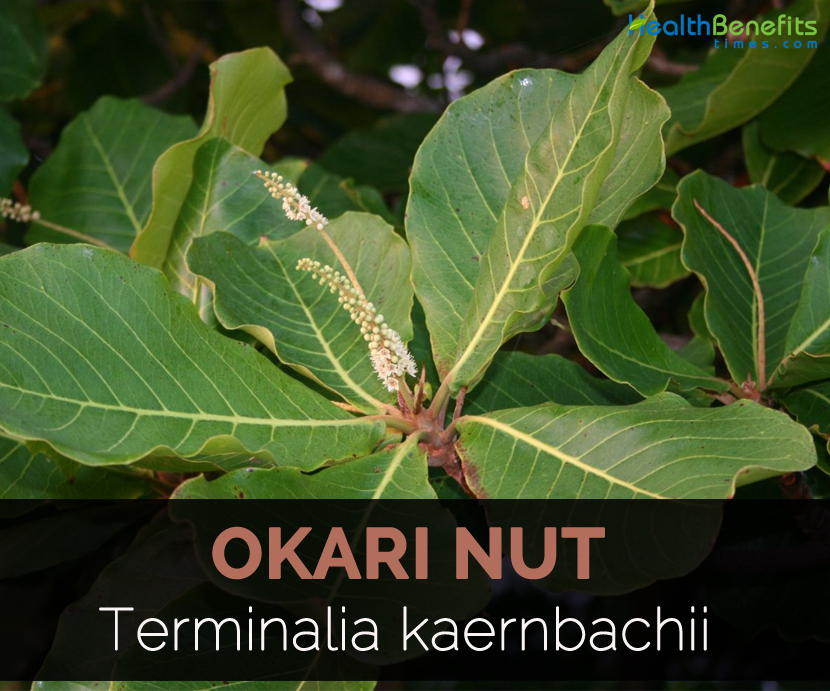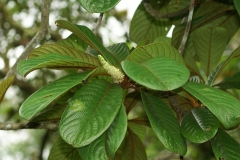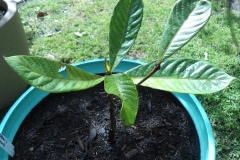| Okari Nut Quick Facts |
| Name: |
Okari Nut |
| Scientific Name: |
Terminalia kaernbachii |
| Origin |
Indonesian Irian Jaya (West Papua), the Aru Islands, Papua New Guinea (Madang, Morobe, Western, Gulf, Central, Northern and Bougainville) and the Solomon Islands |
| Colors |
Brown |
| Shapes |
Ellipsoid, drupe, up to 9–11 cm long by 6–8 cm wide and 5–6 cm thick |
Okari nut is a large, deciduous tree with a spreading crown; it can grow up to 45 meters tall, though it is usually smaller in cultivation. The straight, cylindrical bole is usually buttressed. The seed is a very popular food in the areas where it grows, indeed it is said to be one of the tastiest of all tropical seeds. Commonly harvested from wild trees in the forests, it is also semi-cultivated by the local people there. The seed is often sold in local markets. It occurs in lowland rainforest and riverine forest with wide range of rainfall of 2000-7000 m per annum. It performs poorly near the ocean and grows best inland in lowland and intermediate altitudes below 1000 meters. It tolerates poorly drained soils.
Plant description
Okari Nut is a small and mid-canopy tree about 20-30 meters tall with spreading crown, straight and cylindrical trunk and grey bark. Twigs are massive and hairy when young with crowded leaves towards the tips. Leaves are simple, arranged spirally, obovate or narrow obovate about 15–28 cm long by 6–13 cm broad. Inflorescences are axillary with flowers on unbranched axis. Flowers are unisexual and bisexual about 10 mm across. There are free 10 stamens attached to perianth. An ovary is inferior and carpels are joined. Fruit is a large, ellipsoid, indehiscent drupe upto 9–11 cm long by 6–8 cm wide and 5–6 cm thick and covered with short reddish-brown hairs which is green when young and turn to red, fleshy and glabrous when ripe. It has a massive woody stone with large white to creamy-white kernel and reaches 7–8 cm long by 3–4 cm wide and covered by a thin, brown layer of skin.
Facts about Okari Nut
| Name |
Okari Nut
|
| Scientific Name |
Terminalia kaernbachii |
| Native |
Indonesian Irian Jaya (West Papua), the Aru Islands, Papua New Guinea (Madang, Morobe, Western, Gulf, Central, Northern and Bougainville) and the Solomon Islands |
| Common/English Name |
Okari, Okari Nut |
| Name in Other Languages |
French: Noix d’Okari, Noyer d’Okari;
Japan: Buraun taamineria;
Papua New Guinea: okari (Tok Pisin), sarigi (Pole), Makame (Barai), yumu (Foi), topo (Podopa), favie (Onobasalo), uka (Kaluli), tukai’o ( Etoro), iuwa (Hawalisi);
Solomon Islands: Bush Alite, okari
English: brown terminalia, okari nut
Japanese: buraun taamineria (ブラウンターミネリア) |
| Plant Growth Habit |
Small, mid-canopy, tree |
| Soil |
20–30 m tall |
| Bark |
Grey or grey-brown |
| Leaf |
Obovate or narrow obovate, 15–28 cm long by 6–13 cm broad |
| Flower |
10 mm across |
| Fruit shape & size |
Ellipsoid, drupe, up to 9–11 cm long by 6–8 cm wide and 5–6 cm thick |
| Fruit peel |
Thin, brown |
| Seed |
White to creamywhite, 7–8 cm long by 3–4 cm wide |
| Seed weight |
2.5 to 10 g |
Culinary uses
- Kernels are consumed raw or cooked.
- In East Asia, seeds are consumed raw, roasted or baked.
- Roast the kernels lightly with salt.
References:
https://www.itis.gov/servlet/SingleRpt/SingleRpt?search_topic=TSN&search_value=27761#null
https://pfaf.org/user/Plant.aspx?LatinName=Terminalia+kaernbachii
Comments
comments





